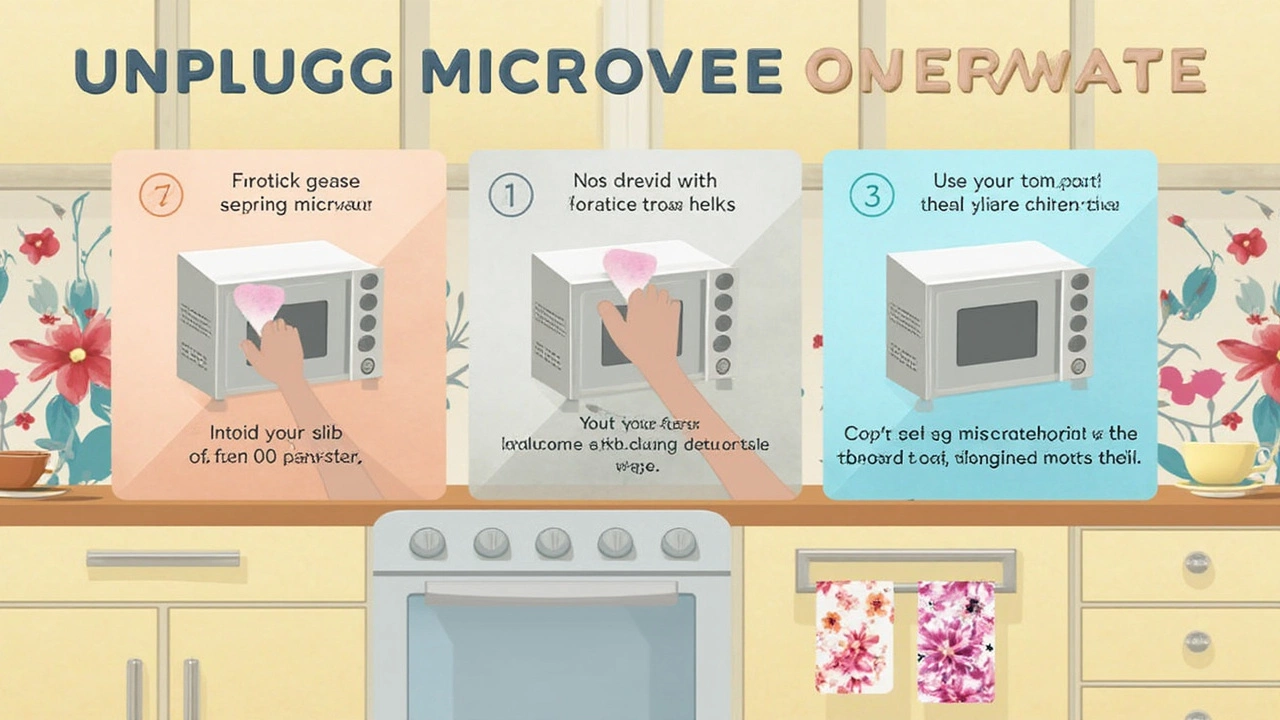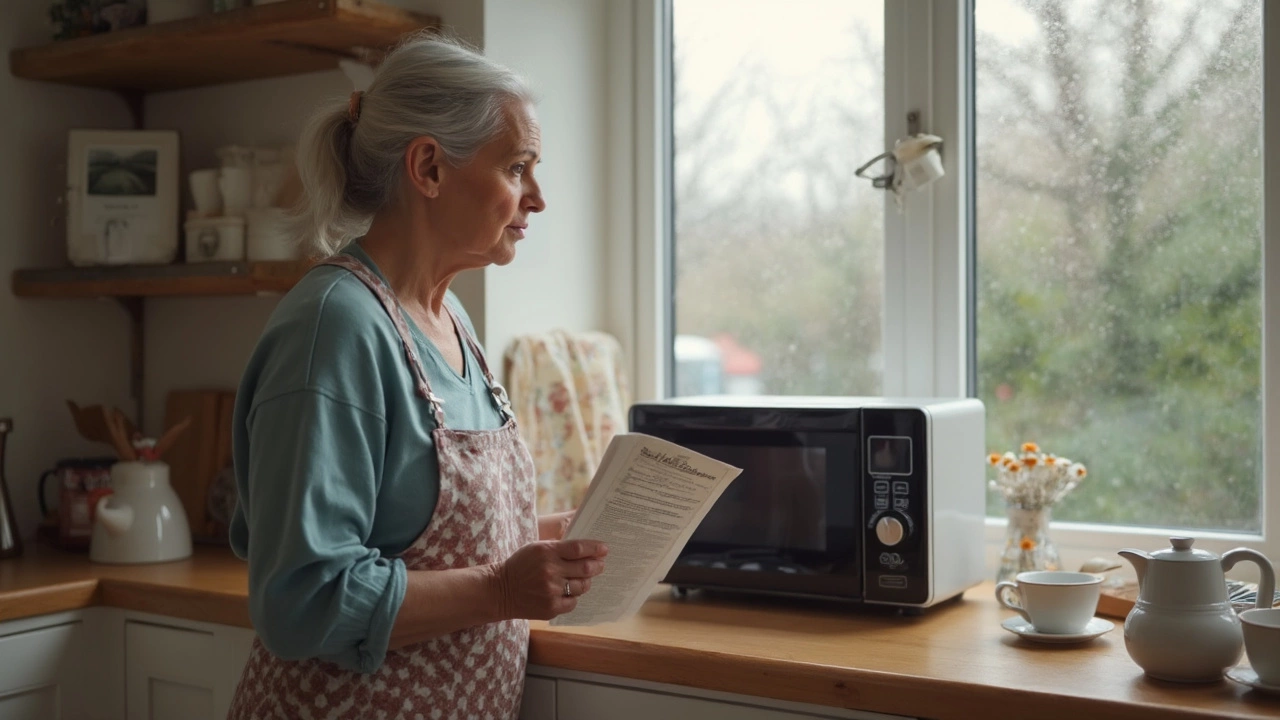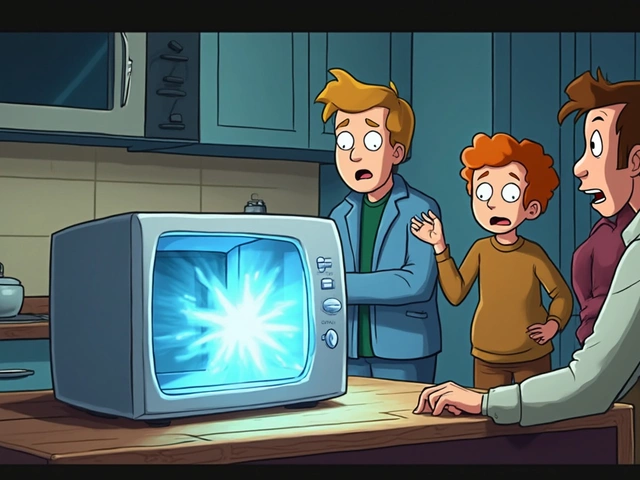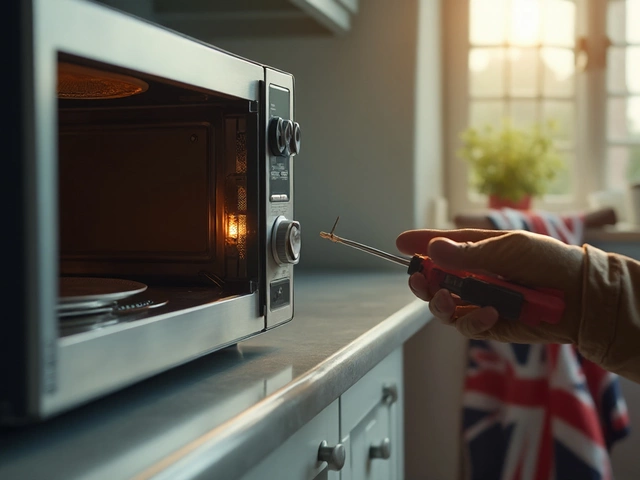Microwaves always break at the worst times—right before a big weekend dinner or when you’re craving late-night leftovers. That humming, everyday kitchen hero isn’t as mysterious as it looks, and you might be surprised how many fixes you can handle on your own.
The first step? Unplug the thing. Don’t mess around with any appliance while it’s still connected to power; microwaves pack a punch with their voltage, even when they’re off. Trust me, safety first doesn’t just sound good—it might save your skin.
Grab a Phillips screwdriver, a flashlight, and maybe some cleaning wipes. You don’t need a fancy toolkit to get started. Most basic microwave troubleshooting begins with looking for loose parts, obvious debris, or worn-out door latches. If you’re hearing strange noises, seeing sparks, or your food just isn’t heating, there could be a quick, DIY fix waiting for you. Let’s figure out what’s up and see if this is something you can actually solve, right there in your kitchen.
- First Things First: Safety and Tools
- Identifying the Problem
- Simple Fixes You Can Do Yourself
- What NOT to Try at Home
- When to Call for Help
First Things First: Safety and Tools
Before you mess with any microwave repair, keep in mind these things aren’t just toasters with a door. Inside is a high-voltage capacitor that can hold enough juice to really hurt you—even when unplugged. Always unplug the microwave first and let it sit for at least 30 minutes before touching anything inside. Never try fixing the magnetron, high-voltage diode, or capacitor unless you’re trained to do so. These are not your average DIY jobs.
For basic fixes, you don’t need much. Here’s what you should have on hand:
- Phillips and flathead screwdrivers
- Needle-nose pliers
- Multimeter (helps check for electrical continuity)
- Cleaning wipes or a soft cloth
- Flashlight
- Insulated gloves (if you plan to touch anything inside)
Ready to do a quick check? Remove loose crumbs or stuck food—that’s the easiest way to prevent random sparks. Worn-out door latches or grimy seals stop microwaves from starting (or make them stop mid-cycle), so clean those spots. Avoid metal tools that could accidentally short anything out, especially near the control board. If you’re ever in doubt, step back and look up a quick tutorial or ask a friend who’s handy with home appliance repair.
Quick fact: In a 2022 survey of households, more than 40% of microwave problems traced back to faulty door latches, dirty connectors, or simple blown fuses—stuff you can easily spot with a bit of attention.
| Common Tool | What It's For |
|---|---|
| Phillips Screwdriver | Opening microwave cover or control panel |
| Multimeter | Testing fuses and switches |
| Needle-nose Pliers | Grabbing loose wires or contacts |
| Insulated Gloves | Risk-free work around electrical bits |
Keeping these tools handy and respecting microwave safety turns a risky job into a doable fix. You don’t need to be an expert, but you do need patience—and your best friend here is caution.
Identifying the Problem
Before you start unscrewing anything, it helps to know what’s actually going wrong with your microwave. Most issues fall into a few categories: it's totally dead, won't heat food, makes weird noises, the turntable won't spin, or there are sparks flying (never good). Knowing the root cause can save you a ton of time—and keep you from fixing things that aren’t broken.
Here’s a quick rundown of symptoms and what they usually mean:
- Microwave won't turn on: Could be a blown fuse, a tripped breaker, or the door switch is shot.
- Not heating up food: Magnetron might be blown, or sometimes it’s as simple as a busted door latch or faulty diode.
- Loud noises: Grinding or humming could mean the turntable motor is failing, or there’s something stuck in the roller track.
- Sparks inside: Usually metal in the microwave, a broken waveguide, or a burnt-out rack support. Sometimes old food splatter causes it too.
- Turntable won't spin: Could be a bad motor or a misaligned roller ring.
According to the appliance pros at Repair Clinic,
“Most microwave problems are caused by something simple, like a door switch issue or blown fuse. Only about 15% of cases involve the main power parts like the magnetron.”So don’t panic—it's rarely the big, expensive stuff.
If you’re still stumped, check this handy chart for quick troubleshooting ideas:
| Problem | Possible Cause |
|---|---|
| Microwave dead | Outlet, fuse, or door switch |
| No heat | Magnetron, high-voltage diode, door latch |
| Sparks | Waveguide cover, metal inside, food splatter |
| Weird noise | Turntable, roller wheel, magnetron fan |
Take note of the symptoms, and match them up with these common causes. This way, you’ll know if the microwave repair is just swapping out a cheap part—or if it’s time to get more serious help.

Simple Fixes You Can Do Yourself
Not every microwave repair calls for a pro. Some problems have surprisingly easy solutions that you can tackle without any special skills. Here’s what you can safely check or try when your microwave isn't working right.
- Microwave Won't Turn On: Is it really plugged in? Sounds obvious, but loose plugs are common. Try another outlet to rule out a dead socket. If you have a tripped breaker, flip it back.
- Door Won’t Close Properly: If the door doesn’t shut tight, your microwave won’t start. Most of the time, it’s food gunk or debris around the latch. Wipe down the latch and the frame with a damp cloth. Sometimes, gently bending the latch (by hand or with pliers) back into place gets things working again.
- Microwave Not Heating: If your food is still cold, check the turntable first. A blocked or off-track turntable can mess things up. Reposition it or remove whatever’s in the way. Also, double-check if you accidentally set the power level too low.
- Weird Noises or Sparks: Did you leave a fork or some foil in your leftovers? Metal and microwaves don’t mix. Remove any metal, check for burned-out covers inside (usually a little plastic window on the wall), and swap it if it’s scorched. Most appliance parts stores carry replacements.
- Smells and Buildup: Bad smells or residues can make your microwave less effective. Clean the inside with a mix of water and vinegar—microwave it in a bowl for two minutes, then wipe down the surfaces.
You’d be surprised how often these fixes do the trick. If your microwave still isn't working after these, don’t start taking apart panels just yet. But for most basic issues, some cleaning and a quick look can save you the cost and hassle of a repair call.
| Problem | DIY Action | Success Rate |
|---|---|---|
| Door won’t close | Clean latch or gently bend back | ~60% |
| Weird noise | Remove metal object, check for stuck turntable | ~70% |
| Food not heating | Reposition turntable, check power level | ~50% |
Remember, always unplug before you poke around inside. These are simple, low-risk fixes that work for most brands and models. Tackling these basics first could get your kitchen running smoothly again without breaking the bank.
What NOT to Try at Home
Okay, here’s the honest truth: some microwave repair jobs are just flat-out dangerous, even if you’re usually handy. If you mess with certain parts, you’re risking a nasty shock—or worse. Microwaves hold a ton of energy in their high-voltage capacitor, and it can zap you even after it’s been unplugged for hours. That’s not the kind of DIY adventure you want, trust me.
So what should you absolutely leave alone at home? Here’s a no-go list for your own safety:
- Never open the magnetron or touch the capacitor. These parts are inside the case, and they’re nothing like changing batteries in a remote. Even brushing against the wrong wire could land you in the ER.
- Don’t try to fix a damaged door seal or latch on your own. If the microwave leaks, it might let dangerous microwaves out. That’s bad news for your health and anyone else in your kitchen.
- Don’t bypass safety switches. Some folks on the internet suggest hacks to make a door work again. That’s a shortcut you do not want to take—microwaves have those switches for a reason.
- Never remove the outer cover to access internal parts. Stuff inside like the transformer and high-voltage parts stay charged long after you unplug. Pros use special tools to drain them, not just a regular screwdriver.
- Forget using random replacement parts from other microwaves. Even if the parts look the same, wattage and voltage ratings matter. Swapping in the wrong part can fry the whole appliance or start a fire.
Check this out—according to U.S. Consumer Product Safety Commission data, over 3,000 emergency room visits happen every year from home appliance repairs gone wrong, and microwaves are a big part of that number.
| Dangerous DIY Microwave Repairs | Why You Shouldn't Attempt |
|---|---|
| Opening magnetron or capacitor | High-voltage shock risk (can cause serious injury or death) |
| Fixing door seal/latch with makeshift repairs | Potential microwave radiation leaks |
| Disabling or bypassing safety switches | Removes key safety features; risk of operating with open door |
| Using incorrect replacement parts | Fire hazard, further damage to microwave |
If you spot any of those problems listed above, shut the microwave down and call a pro. It’s just not worth the risk—saving a few bucks isn’t worth a hospital visit or a kitchen fire.

When to Call for Help
Sometimes, microwave repair is best left to pros. Sure, changing a light bulb or cleaning the turntable is fair game, but if you’re dealing with certain warning signs, stop right there.
- Strange Burning Smells or Smoke: If your microwave smells like burning wires or actually smokes (not just burnt popcorn), unplug it and don’t plug it back in.
- Sparking or Arcing Inside: Little blue lightning or popping noises aren’t normal. If it happens more than once, call a professional. This stuff can start a fire.
- No Power at All: If you plug in the microwave and it’s as dead as a doorknob with no lights or beeps, it might be a dead fuse, blown magnetron, or a fried control board. Those aren’t DIY-friendly.
- Microwave Runs With Door Open: That’s a giant safety risk. Door switches and interlocks are there for a reason. Don’t try to bypass them yourself.
- Unusual Noises or Grinding: If it sounds like metal-on-metal or something’s shaking loose, something important could be broken inside.
Why not crack it open and poke around? Microwaves have something called a high-voltage capacitor. Even after you unplug it, it can store a nasty charge for hours or days. Touching the wrong part inside can knock you flat, and it’s not worth the risk for a home microwave repair job. According to appliance repair pros, most serious microwave injuries at home are from that stored electricity, not from the normal power cord.
If your microwave is over 10 years old and the parts are hard to find or expensive, it might actually cost less to just buy a new one. Here’s a quick look at typical repair costs:
| Problem | Average Professional Cost (USD) |
|---|---|
| Magnetron Replacement | $100 - $200 |
| Fuse Replacement | $50 - $100 |
| Control Panel/Board | $120 - $250 |
| Door Switch Repair | $75 - $150 |
If you’re on the fence, call a repair shop and get a quote. Many offer free estimates. If the fix costs half as much as a new microwave—or more—it’s usually time to say goodbye and upgrade.




